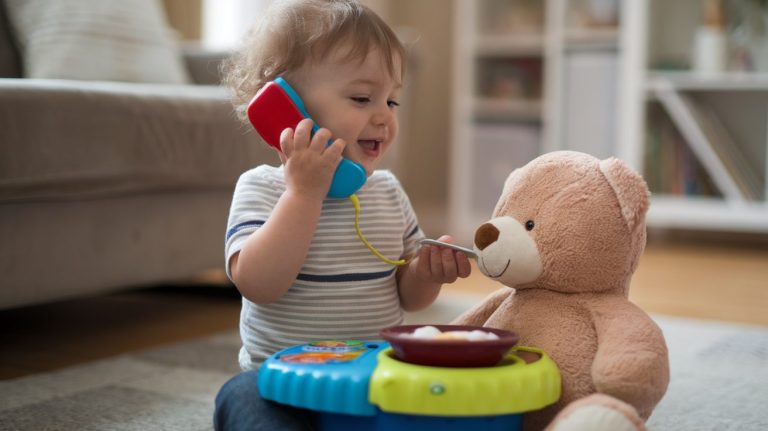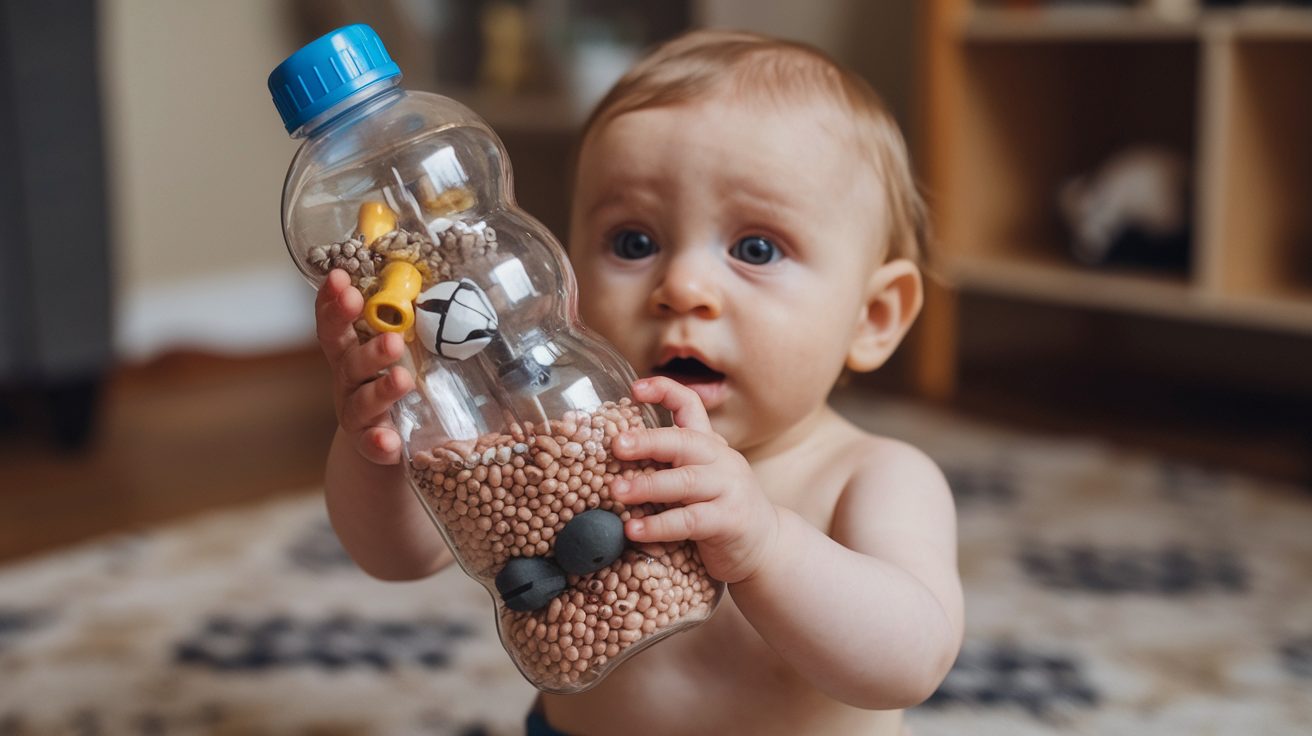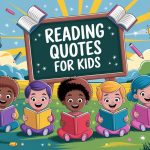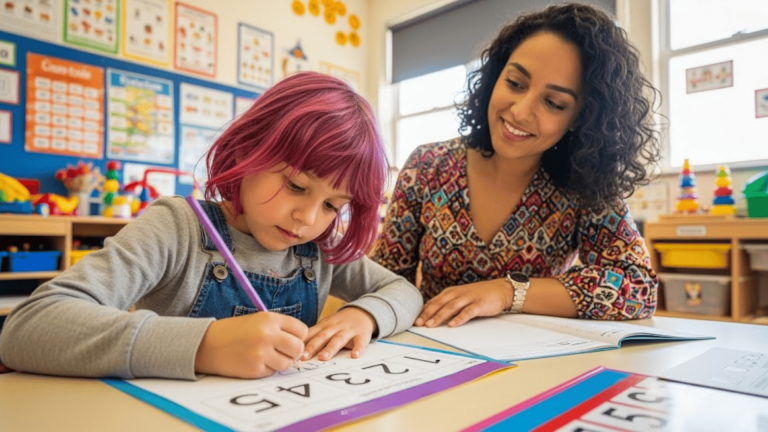Babies at 14 months are curious little learners who need playtime to grow their brains and bodies. Many parents worry about finding the right activities that are both fun and helpful for development.
The good news? You don’t need fancy toys or special skills to give your little one what they needs. Simple, everyday activities can help your baby learn and grow in wonderful ways.
This blog shares easy-to-do activities in three main groups: sensory play that helps your baby learn through touch, taste, smell, sight, and sound; motor skill games that build strong muscles and movement; and brain-building activities that boost thinking and language skills.
By mixing these different types of play into your daily routine, you’ll help your 14-month-old develop all the important skills they need for their next big steps forward.
Let’s look at some simple, fun ways to play with purpose!
Sensory Activities for a 14-Month-Old
Sensory activities help your baby learn about the world by using their five senses. These fun games help their brain grow and make them curious about new things.
1. Sensory Bins
Fill a flat box with safe items like dry pasta, cotton balls, or big buttons. Watch your little one touch, grab, and sort these items.
Stay close by to make sure they don’t put things in their mouth. This helps your baby learn about different shapes and how things feel.
2. Water Play
Put some water in a small tub and add cups, spoons, and plastic toys. Your baby will love splashing, pouring, and watching how water moves.
This helps them learn about wet and dry, full and empty. Always stay right next to your baby during water play.
3. Texture Activity
Collect items with different feels – soft blankets, bumpy balls, smooth blocks.
Guide your baby’s hands over each one and name the feels: “This is soft,” “This is bumpy.” These games teach words for things they can’t see but can feel.
4. Sound Bottles
Make noise makers with empty plastic bottles. Fill them with dry beans, bells, or small rocks (make sure they’re sealed tight!).
Your baby will shake them to make sounds and learn that actions cause effects. This builds thinking skills and helps them notice different sounds.
5. Finger Painting
Spread baby-safe paint on a high chair tray or big paper. Let your baby make marks with their hands.
They’ll love seeing the colors and feeling the cool, wet paint. This helps their hands get stronger for later skills like holding crayons.
6. Sensory Walk
Help your baby walk on different floors – soft rugs, cool tiles, or grass outside. Talk about what they feel: “The grass tickles!”
This helps them learn about their body and builds words for feelings. It’s also good for balance and foot strength.
7. Musical Instruments
Give your baby a small drum, bells, or a pot with a wooden spoon. They’ll enjoy making noise and hearing how sounds change. This helps them learn about loud and quiet, fast and slow. Music games help your baby’s listening skills grow.
8. Scent Activity
Let your baby smell safe things like fresh fruit, flowers, or spices. Watch their face change with each smell! Name each smell as they try it. This builds their sense of smell and adds new words to their growing list.
9. Bubble Fun
Blow bubbles for your baby to watch and try to catch. They’ll be amazed at how bubbles float, shine with colors, and pop! This helps eye tracking and builds hand skills as they try to grab the bubbles.
10. Light and Shadow Play
Shine a flashlight on a wall and make shapes with your hands. Your baby will be amazed at how things appear and go away. This game helps them learn that things can change shape but still be the same thing – an early science lesson!
Motor Skills Activities for a 14-Month-Old
These simple activities can help your little one build strength, balance, and hand skills. Try adding one or two into your daily routine for fun learning moments with your child.
11. Push Toys
A small push cart or similar toy gives your 14-month-old great walking practice. They’ll feel more stable and gain walking confidence while having fun moving around.
This helps build leg muscles and teaches balance. Try putting some small toys in the cart for extra fun and more steps around the house.
12. Climbing Over Soft Obstacles
Create a mini obstacle course with couch cushions, pillows, or foam blocks. Let your child climb over these soft bumps, which build leg strength and body control.
Stay close by to help if needed, but let them figure things out ,too. This helps them learn how their body moves through space.
13. Ball Rolling
Sit on the floor facing your child and roll a soft ball to them. Say “roll it back” when it reaches them.
This simple game builds hand-eye matching, teaches taking turns, and helps their hands get better at grabbing and letting go. Start with bigger balls, then try smaller ones as they improve.
14. Walking with Assistance
Hold your child’s hands while they take steps. This gives them just enough help while they practice walking. As they get better, try holding just one hand.
This builds leg muscles and helps them feel more sure when moving. Make it fun by walking to something they want to see.
15. Stacking Blocks
Big, light blocks are perfect for little hands to grab and stack. Show your child how to put one block on top of another.
Don’t worry if they knock them down right away – that’s part of the fun! This helps finger control and teaches about how things fit together.
16. Dancing to Music
Put on some happy songs and move with your child. Clap hands, twist, bounce, or sway side to side.
Dancing helps them learn balance and body control while having fun with you. Show them simple moves they can copy, like raising arms or turning in circles.
17. Push and Pull Toys
Toys that can be moved across the floor help build arm and leg strength. Try wooden animals on wheels or small cars.
These toys give your child a reason to move around and stay active. They’ll learn about cause and effect as the toy moves when they push it.
18. Crawling Tunnels
A play tunnel or one made from a big box gives your child a fun space to move through. Crawling helps arm and leg strength and teaches them how to plan their movements. Put a toy at the other end as a reason to crawl all the way through.
19. Throwing Soft Toys
Show your child how to toss soft toys into a basket or box. Use stuffed animals or bean bags that are easy to grab. This helps with letting go at the right time – a key hand skill. Start close to the target and make a big deal when they get it in!
20. Playing with Playdough
Soft playdough is great for little hands. Let your child squeeze, pat, and roll it. Show them how to make simple shapes or use cookie cutters.
This builds hand muscles needed later for holding crayons and pencils. Keep a close eye to make sure they don’t eat it!
Cognitive Activities for a 14-Month-Old
These fun activities help your little one’s brain grow stronger! At 14 months, your baby is learning so much about the world. These simple games make learning fun while building important skills.
21. Shape Sorting Toys
Grab a shape sorter with big, easy-to-hold pieces. When your baby puts the square block in the square hole, they’re learning about shapes and solving problems.
Sit with them and say the names of shapes as they play. This helps their brain make relations between what they see and hear.
22. Peekaboo
Cover your face with your hands, then pop out saying “Peekaboo!” Your baby learns that things still exist even when hidden.
This is a big brain step! Try hiding their favorite toy under a blanket and see if they look for it. Their happy giggles show they’re learning.
23. Simple Puzzles
Large wooden puzzles with just a few pieces are perfect. Help your baby match a piece to its spot, then let them try. When they get it right, cheer! This builds thinking skills and helps them understand how things fit together.
24. Reading Books
Pick books with bright pictures and few words. Point to pictures and name them: “Look, a red ball!” Let your baby touch the pages and turn them. Books build language skills and create a loving bond between you two.
25. Imitative Play
Brush your hair, then hand the brush to your baby. Clap your hands, then wait for them to try. When your baby copies you, they’re building memory and learning how things work. This type of play helps them make sense of daily life.
26. Matching Colors
Show your baby two red toys. Say “These are red!” Then show a blue toy and say “This is blue!” Ask your baby to find something red. Even if they don’t get it right, they’re learning to notice how things are the same or different.
27. Object Identification
Hold up common items like a cup, ball, or shoe and clearly say what each one is. Ask your baby, “Where’s the ball?” and see if they look at or reach for it. This helps grow their word bank and links words to real things.
28. Singing Simple Songs
Songs like “Itsy Bitsy Spider” with hand motions are great for little ones. The same words and actions help your baby learn to expect what comes next. Soon they might try the hand motions even before you do!
39. Mimic Animal Sounds
Make animal sounds like “moo” for cow or “woof” for dog while showing pictures. Your baby will try to copy you! This builds speaking skills and teaches them that different animals make different sounds.
31. Pretend Play
Give your baby a toy phone to “talk” on or a spoon to “feed” a teddy bear. When they pretend, they’re learning how the world works. Join in by pretending to take a bite when they “feed” you. This play builds thinking and social skills.
How do These Activities Benefit a 14-Month-Old?
These activities work together to support overall growth—physical, sensory, and intellectual—while keeping learning fun and engaging!
-
Sensory Play (Touch, Taste, Smell, Sight, Sound) – Helps develop neural connections, encourages curiosity, and improves their ability to process different textures, flavours, and sounds.
-
Motor Skill Games (Strong Muscles & Movement) – Strengthens gross motor skills (crawling, walking) and fine motor skills (grasping, stacking), improving coordination and balance.
-
Brain-Building Activities (Thinking & Language) – Stimulates cognitive development, enhances problem-solving and boosts early vocabulary through interaction, play, and repetition.
Conclusion
These fun games do more than just pass the time with your baby. Each activity helps your 14-month-old grow smart and strong in different ways. When babies play with shapes, listen to songs, or look at books, their brains form new bonds.
Parents don’t need fancy toys or special training to help their little ones learn. Simple, everyday moments work best! Try a few activities each day, even for just 5-10 minutes at a time. Watch for signs that your baby is tired or bored, and switch to something new when needed.
Every baby grows at their own speed. Some might love shape-sorting, while others prefer songs. That’s okay! Follow what makes your baby smile and laugh. If an activity seems too hard, break it into smaller steps or try again in a few weeks.
The best part? These simple games build a strong bond between you and your baby while setting them up for success!







































